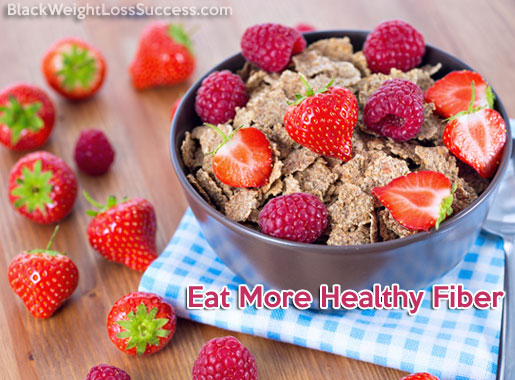 Fiber is a super important nutrient that primarily affects digestive health. Unfortunately, the average American’s diet is lacking in fiber. The typical woman in this country only consuming around 15 grams when she should be consuming at least 30 grams. That’s the average. Many people are eating far less.
Fiber is a super important nutrient that primarily affects digestive health. Unfortunately, the average American’s diet is lacking in fiber. The typical woman in this country only consuming around 15 grams when she should be consuming at least 30 grams. That’s the average. Many people are eating far less.
Aside from general health, there is another reason fiber is so important. It can help you lose weight and maintain a healthy weight! Check out this info, which includes our top 10 fiber picks.
Fiber and Weight Loss
There have been a few studies done on the subject of fiber and its effect on weight. One main study featured in Nutrition Reviews had results that showed participants who ate just 14 grams more of fiber per day lost 4 lbs in 3.8 months. Keep in mind that this result was from only changing fiber intake, nothing else. That is very impressive.
Another study published in the Annals of Internal Medicine confirmed that participants that ate 30 grams of fiber a day with no other dietary changes lost an average of 4.6 lbs. Additionally, those who made further changes and switched to the American Heart Association (AHA) diet lost an average of 6 lbs. The AHA diet is stricter but if you are at risk of diabetes and are overweight, it could be a very good option for you.
Eating more fiber isn’t just as simple as reading labels. There is more to fiber than people realize.
Insoluble vs Soluble Fibers
Did you know that there are actually two types of dietary fiber? Insoluble and soluble fibers are both important for overall health but they do perform different functions in the body. As the terms suggest, insoluble fiber doesn’t dissolve in liquid while soluble fiber will dissolve. The ability to either dissolve or not dictates what benefits you’ll receive.
Despite common misconceptions, soluble fiber is the type that will make you feel full. The reason for this is that this fiber essentially gels when it meets liquid in the stomach. This process make your digestive system slow down which in turn is very beneficial for those who need help controlling insulin levels for their diabetes. There is also speculation that people can lower their bad cholesterol (LDL) by eating more soluble fiber.
You may have been told previously by a doctor, family member or friend to “eat more fiber” when you have trouble going to the bathroom. The fiber that is well-known for helping constipation is insoluble fiber. Essentially insoluble fiber creates the opposite effect of soluble fiber: soluble fibers slow everything down while insoluble fiber helps the digestive tract get everything out. In fact, too much soluble fiber can cause constipation. Insoluble fiber is also essential for maintaining healthy gut bacteria. Insoluble fiber doesn’t break down in water and passes through the system more intact.
Both insoluble and soluble fiber foods should be eaten on a regular basis. With a healthy diet rich in whole foods, getting enough of both fibers isn’t difficult.
10 Delicious Sources of Fiber
You don’t need to drink or eat tasteless, and sometimes expensive, supplements to get your daily intake of fiber. Whole foods not only provide the dietary fiber every woman needs but they also offer many other nutrients that you won’t get from a supplement.
There are many sources of fiber, but these 10 foods not only taste great but also contain the fiber you need to support a healthy digestive system.
- Apples- Soluble
Apples are also a great source of soluble fiber and are a good snack for those with weight loss goals. Eating a typical medium apple will give you 4.4 grams of fiber as well as vitamin A, C and B-6. You will also get magnesium and iron. Apples are fairly high in natural sugars (around 19 grams) so limit yourself if you are trying to lose weight.
- Dates – Insoluble
Being an insoluble fruit, dates are a great way to get some fiber as well as some sweetness. Dates are actually so sweet (93g in 1 cup!) that they work very well in smoothies and other meals as a replacement for sugar. Dates contain 12 grams of fiber in one cup and also are a good source of protein, with around 3.6 grams. Dates are super low in fat and packed with potassium, calcium, vitamin B-6, iron and magnesium. Buy a pack the next time you’re at the grocery store.
- Raspberries and Blackberries – Soluble
Both of these berries are packed with antioxidants that promote overall health. They are very similar in nutrients with one cup of each both being around 8 grams in fiber. Blackberries are a little sweeter so they are higher in calories but not by much. Raspberries contain higher amounts of vitamins C and B-6 while blackberries are higher in vitamin A, calcium, iron and magnesium. Since both fruits are so similar, mixing and matching will help you get enough vitamins from both.
- Wheat Bran – Insoluble
Wheat bran is a huge source of insoluble fiber with 60 grams in one cup. It is also a good source of protein, thiamine, magnesium and iron. Wheat bran can be treated like a cereal, either hot like oatmeal or cold in milk. Since wheat bran is so high in fiber it is extremely filling and a true “secret weapon” for those who are trying to lose weight but often feel hungry.
- Kale – Insoluble
Like many dark leafy greens, kale is essential for good health. It is packed with a ridiculous amount of vitamins (133% of vitamin A and 134% vitamin C) as well as iron, calcium, magnesium and potassium. One cup of chopped kale has roughly 3 grams of fiber and protein. Raw kale leaves put into a green smoothie and baby kale is great in salads as it doesn’t have the bitter flavor of mature plants. If you find you have stomach trouble with raw kale, try cooking it first.
- Butternut Squash – Insoluble
Butternut squash can usually easily be found in the grocery store and tastes delicious- somewhat like pumpkin. It can be cooked in many ways and even mashed as a substitute for potatoes. One cup of butternut squash has 2.8 grams of fiber and 63 calories. It is high in potassium, iron and magnesium. It is also well-known for being super high vitamin A with a level of almost 300%.
- Lentils – Soluble
Lentils contain both soluble and insoluble fiber but are higher in the former. Though lower in fiber than other foods listed (around 1g in 1tbsp) it is still high in other nutrients. Even small amounts are very filling and you can easily use this food as an addition to warm foods like soups.
- Sesame Seeds – Insoluble
Sesame seeds are quite popular in Asian cuisine but are very versatile. They are tasty toasted and raw and can easily be used as a fiber-boost addition to meals like salads. One tablespoon of sesame seeds contains 1.1 grams of fiber and 1.6 grams of protein. These seeds are also high in calcium, magnesium and iron.
- Kiwi – Soluble
These sweet green fruits are small but pack a nutrient punch with 106% vitamin C and 2.1 grams of fiber. They are fairly low in sugar, 6 grams, so they are a good fruit for people trying to lose weight. Kiwi is high in enzymes similar to pineapple so consuming multiple fruits can have your tongue to feel irritated.
Fiber is a super important part of a good diet yet often overlooked when other nutrients like protein take precedence. Whether you are trying to lose weight, struggling to keep under your daily calorie limit or just are experiencing digestive problems, eating more of the foods featured here and others will help you get the results you are looking for.

Comment Via Facebook